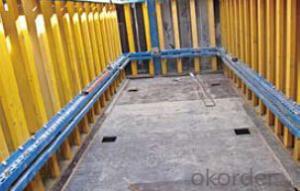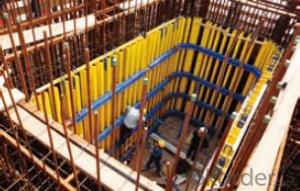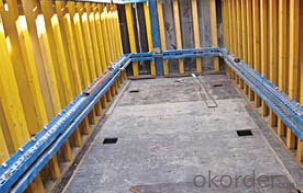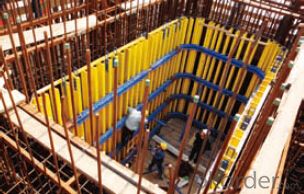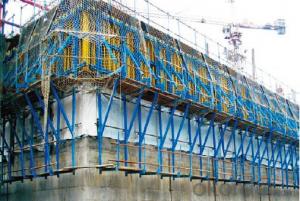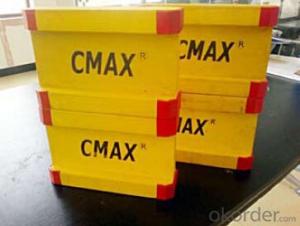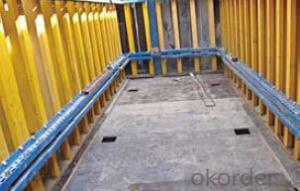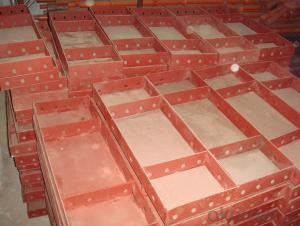Shaft-Platform System For Formwork and Scaffolding
- Loading Port:
- Tianjin
- Payment Terms:
- TT OR LC
- Min Order Qty:
- 50 m²
- Supply Capability:
- 1000 m²/month
OKorder Service Pledge
Quality Product, Order Online Tracking, Timely Delivery
OKorder Financial Service
Credit Rating, Credit Services, Credit Purchasing
You Might Also Like
Shaft Platform
As operating platform, the shaft platform is mainly used in the concrete pouring of elevator shaft,
equipment shaft, stair shaft of high-rise building and so on.
Characteristics:
◆ The length of shaft beam is adjustable.
◆ Flexible structure makes lifting easier.
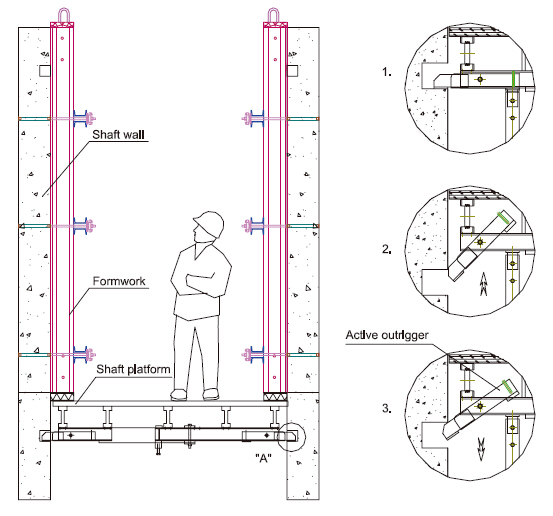
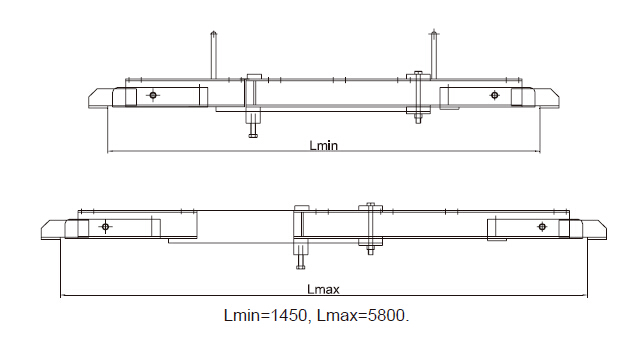
- Q: What is the standard thickness of steel formwork
- Generally, the height of the column template is set at 1.52 or 0 5m in order to be easy to use.
- Q: What are the common safety precautions when working with steel formwork?
- To ensure the safety of workers and prevent accidents when working with steel formwork, it is important to adhere to several common safety precautions. These precautions encompass the following: 1. Mandatory training: It is imperative that all workers who engage in the use of steel formwork undergo comprehensive training on its assembly, disassembly, and usage. This training should encompass all safety procedures and precautions. 2. Utilization of personal protective equipment (PPE): Workers must consistently wear suitable PPE, including safety helmets, safety glasses, hearing protection, gloves, and steel-toed boots. These protective measures will safeguard them against potential hazards, such as falling objects, flying debris, and sharp edges. 3. Thorough inspection of formwork: Before commencing any work, a meticulous inspection of the steel formwork should be carried out to identify any defects, damage, or signs of wear. Any damaged or faulty components must be promptly repaired or replaced to maintain structural integrity and avert accidents. 4. Firm footing: It is crucial for workers to have a secure footing when working with steel formwork. This can be achieved by employing appropriate scaffolding, ladders, or working platforms. Additionally, any surfaces that are prone to slipperiness should be addressed by using non-slip materials or applying anti-slip coatings. 5. Implementation of fall protection measures: Adequate measures for fall protection should be in place, particularly when working at elevated heights. This may involve the use of guardrails, safety nets, or personal fall arrest systems (PFAS) to prevent falls and safeguard workers in the event of an accident. 6. Effective communication and coordination: When dealing with steel formwork, efficient communication and coordination among workers are paramount. Clear communication of tasks, instructions, and potential hazards can help prevent accidents and maintain a safe working environment. 7. Adherence to proper lifting techniques: When handling heavy steel formwork components, workers should employ appropriate lifting techniques to avoid strains, sprains, or other injuries. This includes lifting with the legs rather than the back, utilizing mechanical lifting aids when necessary, and seeking assistance for heavy or unwieldy loads. 8. Fire safety precautions: Steel formwork can pose a fire hazard, thus necessitating the implementation of fire prevention measures. This involves ensuring the availability of adequate fire extinguishers, maintaining unobstructed access to fire exits, and designating a specific fire assembly point. By observing these common safety precautions, workers can minimize the risk of accidents and injuries when working with steel formwork. It is imperative for all workers and supervisors to prioritize safety and maintain vigilant throughout the entire construction process.
- Q: What are the common design considerations for steel formwork in marine environments?
- Some common design considerations for steel formwork in marine environments include corrosion resistance, durability, strength, and stability. Steel formwork used in marine environments should be made from corrosion-resistant materials, such as stainless steel or galvanized steel, to prevent degradation due to exposure to saltwater. It should also be designed to withstand harsh weather conditions, including high winds and waves, to ensure its longevity. Additionally, the formwork should have sufficient strength and stability to support the weight of concrete and withstand the forces exerted by the marine environment. Proper sealing and maintenance of the formwork are also vital to prevent water infiltration and maintain its effectiveness.
- Q: How does steel formwork affect the overall sound insulation of a building?
- The overall sound insulation of a building is not directly affected by steel formwork. The quality and design of the walls, floors, and ceilings are the main factors that determine sound insulation, regardless of the formwork material used. However, sound insulation may be indirectly influenced by steel formwork during the construction phase. Steel formwork is renowned for its rigidity and strength, which ensures precise and accurate pouring of concrete. This precise construction technique helps minimize gaps and imperfections that can occur during the concrete casting process. Consequently, steel formwork contributes to creating a smoother and more uniform concrete surface, reducing the possibility of sound leakage through cracks or joints. Additionally, steel formwork can be employed to create even and smooth surfaces, facilitating the installation of soundproofing materials like acoustic panels or insulation. These supplementary soundproofing measures, when incorporated during construction, can enhance the overall sound insulation of the building. It is important to recognize that although steel formwork can indirectly impact sound insulation during construction, the primary elements affecting sound insulation are the materials and techniques utilized in constructing walls, floors, and ceilings. Architectural design, insulation materials, and sealing techniques all play a crucial role in achieving optimal sound insulation levels.
- Q: What are the different material handling requirements for steel formwork?
- The different material handling requirements for steel formwork involve proper storage, lifting, transportation, and maintenance of the steel components. Steel formwork should be stored in a dry and secure area, away from moisture and exposure to the elements. When lifting, it is essential to use appropriate lifting equipment and follow proper rigging procedures to ensure the safety of workers and prevent damage to the formwork. During transportation, the steel formwork should be securely fastened and protected from any potential impacts or vibrations. Regular maintenance, including cleaning, inspection, and repair, is crucial to ensure the longevity and performance of the steel formwork.
- Q: How does steel formwork contribute to the overall safety of workers?
- Steel formwork contributes to the overall safety of workers in several ways. Firstly, steel formwork is known for its strength and durability, providing a stable and secure structure for workers to perform their tasks. This stability minimizes the risk of accidents and collapses, ensuring the safety of workers. Additionally, steel formwork is designed to be fire-resistant, offering protection in case of fire emergencies. This feature significantly reduces the risk of injuries and provides workers with valuable time to evacuate the area safely. Moreover, steel formwork is engineered to be resistant to various weather conditions, such as strong winds and heavy rains. This resistance prevents formwork from becoming unstable or collapsing during adverse weather, minimizing the risk of accidents and injuries for workers on-site. Furthermore, steel formwork is typically designed with safety features such as non-slip surfaces and handrails, enhancing worker safety by providing better grip and stability when moving around the structure. These features help prevent slips, trips, and falls, which are common causes of accidents on construction sites. Another important aspect is that steel formwork is reusable and can be easily assembled and disassembled. This reduces the need for workers to carry heavy materials or tools, decreasing the risk of strain injuries and fatigue-related accidents. Lastly, steel formwork is designed to ensure proper support and alignment, minimizing the risk of structural failures or collapses during concrete pouring. This precise alignment ensures the stability of the structure and reduces the likelihood of accidents that could endanger workers' safety. In conclusion, steel formwork plays a crucial role in enhancing the overall safety of workers. Its strength, durability, fire resistance, weather resistance, non-slip surfaces, and proper support contribute significantly to creating a secure working environment, reducing the risk of accidents, injuries, and structural failures.
- Q: How does steel formwork affect the overall sustainability of a concrete structure?
- Steel formwork can have a significant impact on the overall sustainability of a concrete structure. Firstly, steel formwork is reusable, which means that it can be used for multiple construction projects, reducing the need for additional materials and minimizing waste. This reusability also helps reduce the environmental impact associated with the production and disposal of formwork materials. Additionally, steel formwork is durable and robust, which ensures that it can withstand repeated use without compromising its structural integrity. This durability extends the lifespan of the formwork, reducing the need for frequent replacements and further reducing waste generation. Furthermore, steel formwork provides superior strength and stability, allowing for the construction of concrete structures with greater precision and efficiency. This facilitates the use of less concrete, reducing the overall carbon footprint of the structure. Additionally, the use of steel formwork can result in faster construction times, minimizing energy consumption and reducing the project's environmental impact. Moreover, steel formwork allows for greater flexibility in design and construction techniques, enabling the creation of more sustainable structures. It can be easily customized to fit various shapes and sizes, optimizing the use of space and reducing material wastage. This flexibility also allows for the integration of sustainable features such as energy-efficient insulation, green roofs, or rainwater harvesting systems. In summary, steel formwork positively impacts the overall sustainability of a concrete structure through its reusability, durability, strength, and flexibility. By reducing waste generation, minimizing the use of concrete, and enabling sustainable design options, steel formwork contributes to the creation of more environmentally-friendly and efficient structures.
- Q: Can steel formwork withstand extreme weather conditions?
- Yes, steel formwork is designed to withstand extreme weather conditions. Steel is known for its strength and durability, making it highly resistant to harsh weather elements such as heavy rain, strong winds, and high temperatures. Additionally, steel formwork is often treated with protective coatings to further enhance its resistance to corrosion and degradation caused by extreme weather conditions.
- Q: How does steel formwork affect the overall construction site productivity?
- The overall productivity of a construction site can be significantly influenced by the use of steel formwork. One of the main advantages of steel formwork is its durability and strength, which allows for multiple reuses on various construction projects. This reusability factor reduces the time and resources needed for formwork installation, thereby increasing the productivity of the construction site. In addition, steel formwork offers better accuracy and precision in shaping concrete structures compared to traditional wooden formwork. The standardized dimensions and design of steel formwork ensure consistent and uniform results, minimizing the need for adjustments or corrections during the construction process. This leads to faster and more efficient construction, saving time and improving productivity. Furthermore, steel formwork is easy to assemble and disassemble, enabling quick and efficient formwork installation and removal. This reduces the idle time of workers and equipment, maximizing resource utilization and increasing productivity on the construction site. Moreover, steel formwork provides excellent strength and stability, allowing for higher concrete pouring rates and reducing the risk of formwork failure. This allows construction teams to work at a faster pace, pouring larger volumes of concrete in a shorter period, ultimately enhancing overall productivity. Lastly, steel formwork is highly resistant to adverse weather conditions and can withstand harsh environments. This durability ensures that construction activities can continue without interruptions caused by bad weather, leading to improved site productivity. In conclusion, the use of steel formwork positively impacts construction site productivity by offering durability, reusability, accuracy, ease of assembly, and resistance to weather conditions. These factors contribute to faster construction, reduced downtime, and optimized resource utilization, ultimately enhancing overall productivity on the construction site.
- Q: What are the different types of tie systems used in steel formwork?
- There are several different types of tie systems that are commonly used in steel formwork in construction projects. These tie systems are designed to provide stability and support to the formwork during the concrete pouring process. Some of the main types of tie systems used in steel formwork include: 1. Tie rods and wing nuts: This is the most commonly used tie system in steel formwork. It consists of steel rods that are inserted through the formwork panels and secured with wing nuts. This system allows for quick and easy assembly and disassembly of the formwork. 2. Shear connectors: Shear connectors are used in situations where there is a need to transfer shear forces between the formwork and the concrete. These connectors typically consist of steel bars that are embedded in the concrete and connected to the formwork. 3. Steel form ties: Steel form ties are used to hold the formwork panels together and maintain the desired shape and alignment during concrete pouring. These ties are typically made of steel and are available in various lengths and sizes to accommodate different formwork requirements. 4. Adjustable formwork systems: These systems are designed to provide flexibility in adjusting the formwork to different shapes and sizes. They often incorporate adjustable brackets and clamps that allow for easy and precise alignment of the formwork panels. 5. Stay-in-place formwork systems: Stay-in-place formwork systems are designed to remain in place after the concrete has cured, eliminating the need for formwork removal. These systems are typically used in applications where the formwork is intended to become a permanent part of the structure, such as in bridges or tunnels. Overall, the choice of tie system in steel formwork will depend on factors such as the project requirements, structural design, and the specific conditions of the construction site. It is important to select a tie system that can provide the necessary stability and support for the formwork, while also considering factors such as ease of installation, reusability, and cost-effectiveness.
Send your message to us
Shaft-Platform System For Formwork and Scaffolding
- Loading Port:
- Tianjin
- Payment Terms:
- TT OR LC
- Min Order Qty:
- 50 m²
- Supply Capability:
- 1000 m²/month
OKorder Service Pledge
Quality Product, Order Online Tracking, Timely Delivery
OKorder Financial Service
Credit Rating, Credit Services, Credit Purchasing
Similar products
Hot products
Hot Searches
Related keywords
